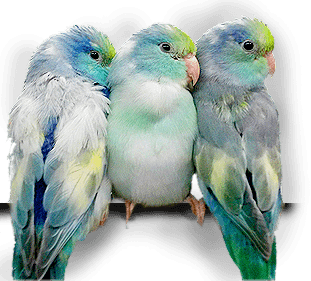The Genetics of Dark Factor Parrotlets
Today we will be discussing dark factor Parrotlets/dark parrotlets. For this discussion, we will be using abbreviations for dark factor and double dark factor mutations. Dark factor parrotlets are bred primarily by European and Asia breeders. It is very difficult to find them in America. To give you an idea on dark factor birds we will now name a few of the birds in question.
- green normal,
- dark green
- dark factor green/ DF
- double dark factor green/ DDF
- dark factor green and double dark factor green are called olive green.
The double dark factor green or olive green will be the darkest in the green collection. Creating this bird correctly can easily take up to 2 to 3 years, also in dark factor birds there are no splits. Meaning if you have a clutch of five dark factor green you will have to wait for them to a up and malt and then and only then can you see which of the clutch is darker than the other, you will have to visually pick out and know the difference between DF, and DDF and dark green. Once you have achieved your goal on the dark factor green that you are looking for, then you are ready to move on to what you are trying to create. The DDF in appearance as a very dark drab green with black feathers or sometimes even Brown going through their back, if you have created such a bird consider yourself XTREEMLY lucky!
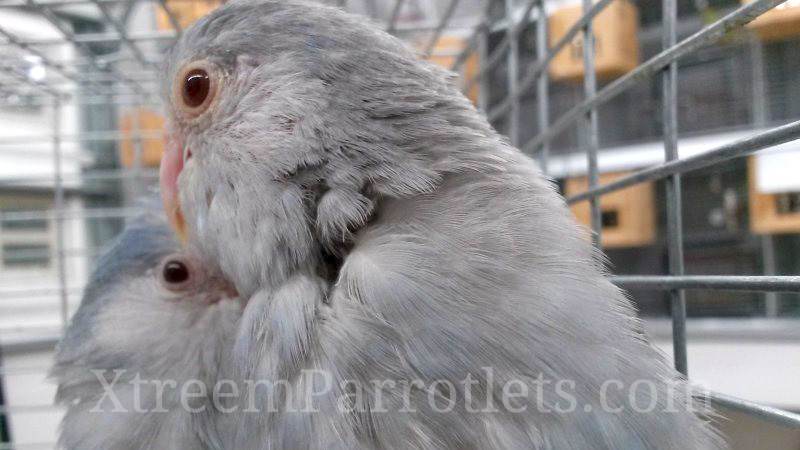
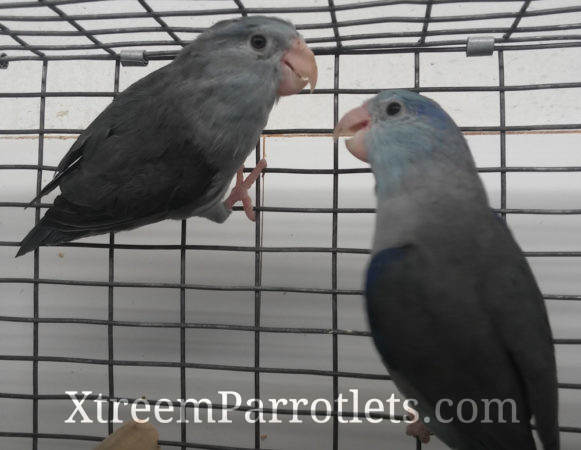
Xtreem parrotlets has associated itself with three Asian breeders, they have mastered the dark factor Parrotlet. They have the darkest mauve I have ever seen, and also they have allowed me to see pictures of all the in between stages and birds that it takes to get there to have such an awesome mauve. We will display a DDF olive green to show you what a real DDF olive green looks like, picture courtesy of our friend in Thailand. xtreem parrotlets has 2 pairs of young DF olive Parrotlets bonding, it will be several months before any first clutch, then we will have to wait for the babies to feather up then molt before we can visually distinguish the difference between a dark green, DF olive and DDF olive. We feel that it will take several clutches to harvest a decent amount of DF olive or dark factor olive green parrotlets. It will take some time before we have enough stock so that we can sell dark factor parrotlets to our interested clients.
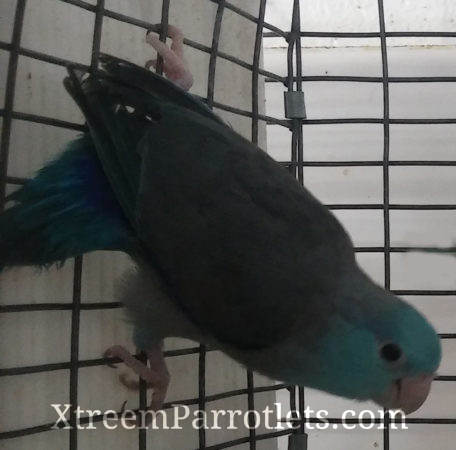
We will now discuss the dark factor blue Parrotlet, also known as the cobalt blue. The cobalt blue Parrotlet also comes in different levels, level #1 cobalt blue, level #2 dark cobalt, level #3 dark factor cobalt, level #4 double dark factor cobalt. Certain combinations of these dark factor parrotlets will produce a dark factor mauve Parrotlet. The mauve Parrotlet having medium to dark gray chest, head and face, with gray black flight wings. To achieve this type of DF Parrotlet you would need a double dark factor/DDF cobalt blue. The same breeding techniques for the dark factor cobalt blue, would be the same as the dark factor green collection. To distinguish a dark cobalt blue from a DF cobalt blue, or a DDF cobalt blue would have to be done visually, there are no splits to dark factor parrotlets. Once again they would have to age and then molt, then you can get a true color reading on the bird to see what level of dark factor cobalt you have. One thing you will definitely need to complete this process, a huge amount of patients also time. To achieve creating the mauve Parrotlet you will need a dark factor olive paired with a dark factor mauve, I prefer a pairing with a DDF mauve, with a DF olive Parrotlet. You can reference our charts with its content which we have to share with all interested clients. We will continue to work and share all of our knowledge and experience to all interested parties thank you from Xtreem Parrotlets. On the follow page we will share some of our pictures of our dark factor parrotlets.
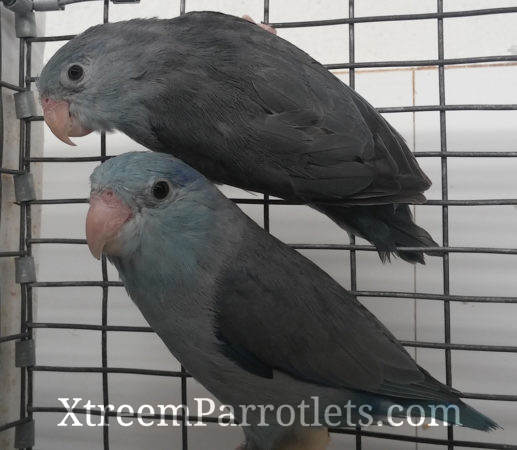
We will now share some pictures of dark factor parrotlets, we have had a pair of dark factor mauve fallow parrotlets, producing these DF birds was quite the challenge. We also have dark factor turquoise which we are now in the process of breeding, we will share some pictures with you, we also showcase the dark factor turquoise on our Facebook page, creating the dark factor turquoise Parrotlets was a great challenge. We also have dark factor cobalt cinnamon fallow pied, we are currently working on pairing it with a double dark factor Parrotlet that will produce an extremely dark factor cinnamon. That pairing will take some time. Also we are working on the dark factor cobalt as well as many other dark factor parrotlets such as pieds and also a certain variety of fallow mutations, it’s going to be a lot of fun and it’s going to take a long time and it’s gonna take a lot of patience but stay tuned because we always take it to the extreme.
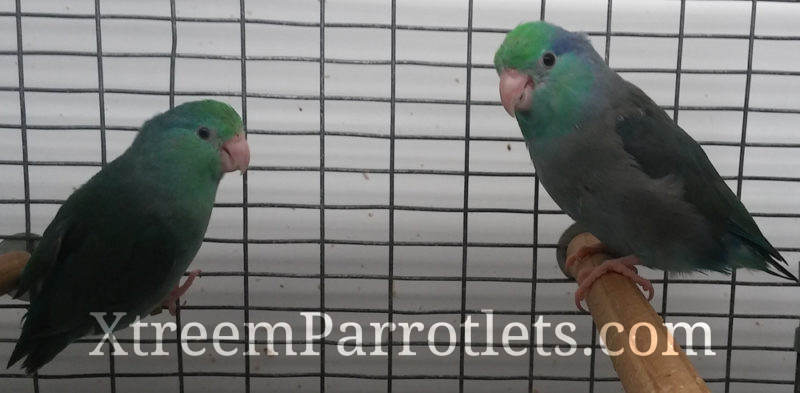
The genetics of dark factor Parrotlet color mutations are better understood by the serious breeder. Dark factor genetics can only be passed on to the offspring. Dark factor genetics cannot be split. There are no Parrotlet mutations that are split to dark factor. The genetic codes in dark factor parrotlets will not allow for splits. Again dark factor genetics can only be passed on to the offspring. First, we have the dark mutations. Second, we have dark factor= DF, third we have double dark factor= DDF. These abbreviations will be used for the blue series as well as the green series.
There is much controversy about the dark factor mutations in America. Some European breeders believe that there are no such dark factor blue or green or cinnamon in the US. Xtreem Parrotlets disagrees, it is true that any dark factor Parrotlet mutations in the United States are few. However, there are some breeders that do possess the dark factor mutation. Some European breeders are great at lecturing U.S. breeders about this bird, they supply us with charts and a small amount of content on how to achieve a dark Parrotlet. We Americans already know how to create dark birds. But the Europeans leave out one important factor. Their educational content has a beginning and an end, but they conveniently leave out the middle the most important part how do you create a dark factor Parrotlet?
My question is why? Why do they leave this critically important fact out? There are only three explanations, they either don’t know that level of knowledge, or they can’t, or perhaps they are just not willing to share. You be the judge. We have researched this on several European websites that claim to be experts in the genetics and breeding of dark factor Parrotlet mutations. Not one European breeder can tell us how to genetically create the DF/DDF mutation. They have a beginning and they have an end but no middle. Yes, they will showcase some of the most beautiful DF and DDF olive green and dark gray and dark wing mauve mutations anywhere on the planet.
Our friends throughout the European states also tell us the mauve and olive mutations are easily available to purchase in their country and are relatively inexpensive. If what they are saying is true then they are not the rare mutation that we thought they were.
Xtreem Parrotlets have also exported our turquoise mutations to Thailand and the U.K. we also have our fame turquoise Parrotlet color mutations now in Belgium, Germany, and Denmark. Our breeder friends in Thailand have what we consider to be the true color mauve. These mutations are absolutely stunning, they are literally pale purple, and others are pale violet blue. We find the breeders in Thailand are much more willing to share their knowledge to create such rare and exotic Parrotlet color mutations. They also have the darkest almost black DDF mauve Parrotlet mutations we have ever seen. They have even added turquoise to the DDF mauve, absolutely stunning. Also with regards to their DDF green olive, they have also added pied to the mix, just fascinating! Our compliments to these breeders in Thailand.
We will now share with you briefly on a breeding method on how to create a dark factor mutation. This method is not for everyone. You must have many years of breeding experience and know the true meaning of what color is. You must have deep knowledge of genetics, chromosomes, color genes, and what a factor gene is. Also many years of breeding experience and most of all much time and patience.
Step one, you will need a fallow Parrotlet preferably green, the green fallow will have a dark back it can either be a medium to dark cinnamon or brown. Remember the fallow gene manipulates color that is key to this process. You must think outside of the box, you must ask yourself how do I isolate the dark fallow color gene cinnamon/ brown into the mutation I want to create? Your task is difficult you must isolate the dark this factor gene which is present in the fallow bird you must extract it. You will want to use a male for this method.
Many fallow mutations have a chromosome that holds a dark factor gene. The female of choice would be the darkest green split to fallow pied you can find. Your pair will consist of one male green fallow dark back either cinnamon or brown and one female dark green pied split to fallow. This is where the time and patience come in, eventually, they will produce one or two solid dark brown green male and deep rich green with a cinnamon sheen throughout the body and the wings will be a darker drab green. The male will show off its dark cinnamon/ brown easily visible. And will maintain a deep rich green face sometimes with a wash of cinnamon. There you will have a DF green brown/cinnamon mutation. Once you have this DF green/ cinnamon/brown mutation, you would best pair it with a dark blue cobalt. This will result in an even darker DF/green olive mutation.
Even though this method of breeding is highly advanced and everything must exactly correct, it is very, very, time-consuming. Xtreem Parrotlets are now showcasing the fruit of our labor, we have created from our breeding by design method our very own from scratch DF color mutation. We have sent pictures to our breeder friends that have bred many DF/DDF mutations throughout Europe and Thailand all agree that these DF mutations bred by Billy XTREEM are in fact DF mutations. They cannot fathom the method I used, and I quote it is pure genius! Our DF mutations are now paired up with dark blue cobalt they are now bonded and in the breeding, the situation can’t wait to see the results so stay tuned.
Now we would like to discuss Dark Parrotlet color mutations. Xtreem parrotlets now have 10 pair beautiful healthy robust dark blue cobalt pairs that are now just a few months away from breeding age. These blue cobalt’s or definitely DARK! We will make them available for sale within the next several months one pair is already checking out the nest box. The blue series is as such, blue normal, cobalt blue, dark cobalt blue, DF blue and DDF blue. We have seen many dark cobalt blues from around the world and some are saying they are DF blue. They mirror our dark cobalt blue, we feel that’s a good thing.
Now we will discuss the dark factor DF/DDF in the green series. We have spent some time explaining Billy XTREEMS breeding by design method on how to create your own DF green color mutation. So we will not spend much time but briefly, state the order in which the green series comes from without breeding them with dark cobalt blue Parrotlet color mutations, footnotes the darker the green you want you must pair with dark cobalt blue and finally dark factor blue. The order is as such. Clean green/green normal, slightly darker green/B, dark green, DF green and finally DDF green better known as dark olive green. Again to achieve the DDF green you must pair with a DF blue. Also remember DF mutations are not split they are no split to dark factor/DF/DDF. That’s what makes the breeding of dark factor Parrotlet color mutations so difficult and time-consuming. Hats off to the most Talented breeders in Thailand as well as some of the breeders in the UK and other European states. Not to worry Xtreem Parrotlets is working diligently to export our famous turquoise signature collection to all of you.
PLEASE NOTE: THESE DRAWINGS ON DARK FACTOR PARROTLETS ARE AVAILABLE ON MANY OTHER SITES LOCATED THROUGH OUT THE U.S. AND ARE USED AS A REFERENCE TO SHARE WITH OUR FRIENDS. WE HOPE THEY ARE A HELP TO YOU ALL.
Xtreem Parrotlets has quietly invested the last two and one-half years on the research and development of dark factor green and blue parrotlets. We will be investing the two years on the completion of double dark factor (DD) blue and olives that will give us the rare mauve parrotlet. During this process, as always we have taken our breeding techniques to the Xtreem. We have now in our possession DD factor turquoise parrotlets which pictures are showcased on Facebook!
Dark factors are a visual genetic alteration which CAN NOT be carried as a ‘split’.
Single Dark factor (D) mutations are identified as Dark Green (the Green series) and Cobalt (the Blue series)
Double Dark (DD) factors are identified as Olive ( the Green series) and Mauve ( the Blue series)
Like with the standard blue mutation pairing any green to a blue will only breed visual blues if the green is split blue… so will be the same calculations for dark factors.
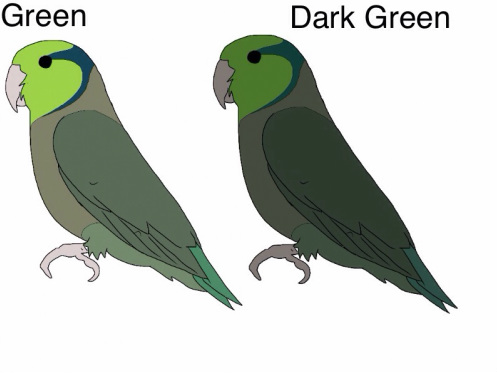
This pairing means that only the dark green parent will pass on a Single Dark factor gene to its young. So basically 50% will be green (wild colour) and due to half the parents putting in the dark gene 50% dark greens.
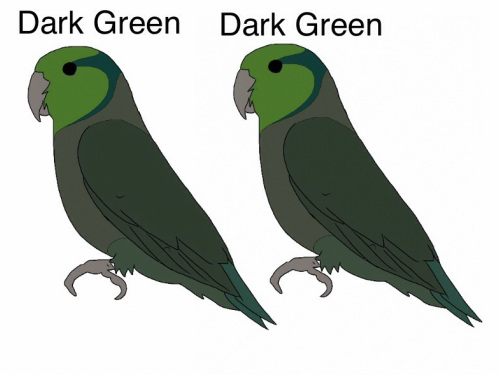
Pairing a dark factor green to a dark factor green means that each parent has the chance of giving its offspring a single factor gene and also the chance of doubling up on the dark factor to produce double dark factor offspring.
Offspring will be 25% green, 50% dark green and 25% olive
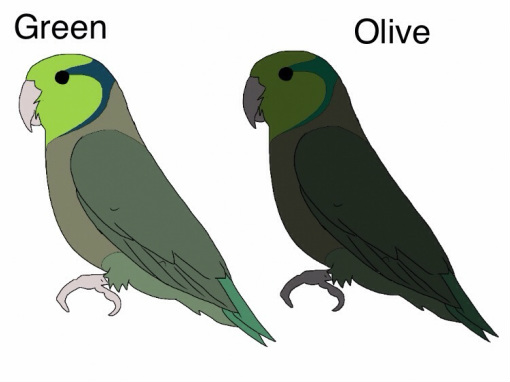
In this pairing the dark factor is carried over once (from the Olive) as a normal visual green is unable to pass on a dark factor. This pairing will breed 100% dark greens.
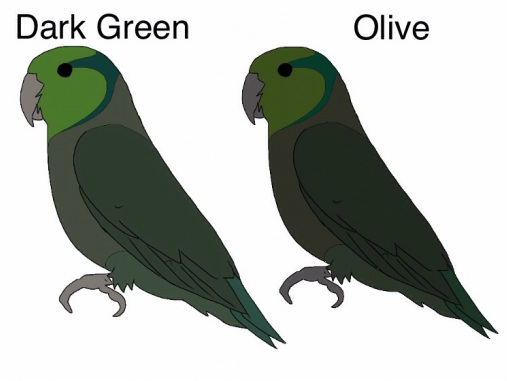
Both parents are carrying the dark factor gene so chances are 50% dark green and 50% olive. You will not breed greens. But this pairing is not ideally the way to breed olives. Olives are still small in size and we need to improve the quality of bird by pairing back to good greens and trying to breed really good sized dark greens.
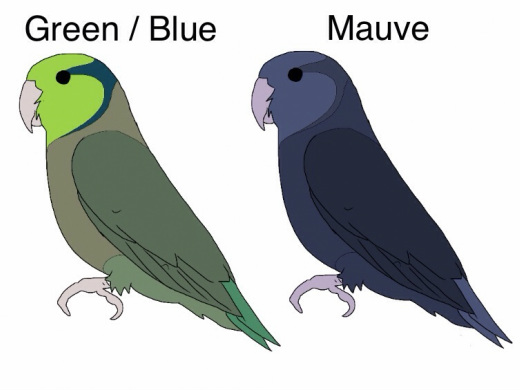
50% dark green/blue and 50% cobalt
No olives or mauves as the normal Blue parent isn’t carrying a ‘D’ factor. Only the one parent is carrying the dark gene (twice). This combination can be used the same if you have a blue x olive split blue.
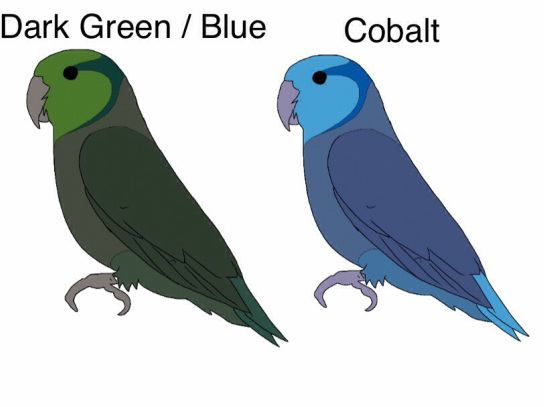
This one is a huge combination…..
12.5% blue
12.5% green split blue
25% cobalt
25% dark green split blue
12.5% mauve
12.5% olive split blue.
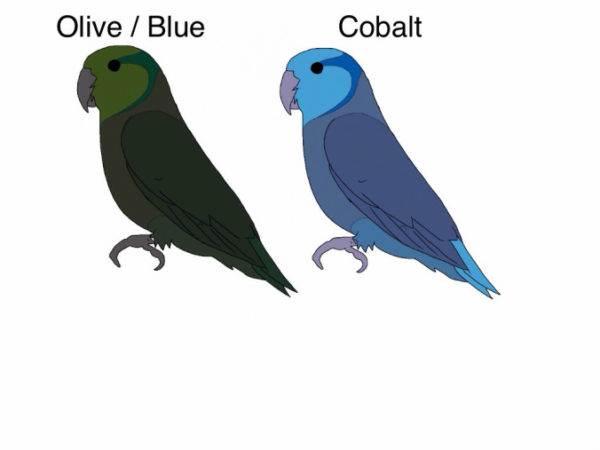
See More Xtreem Parrotlets
